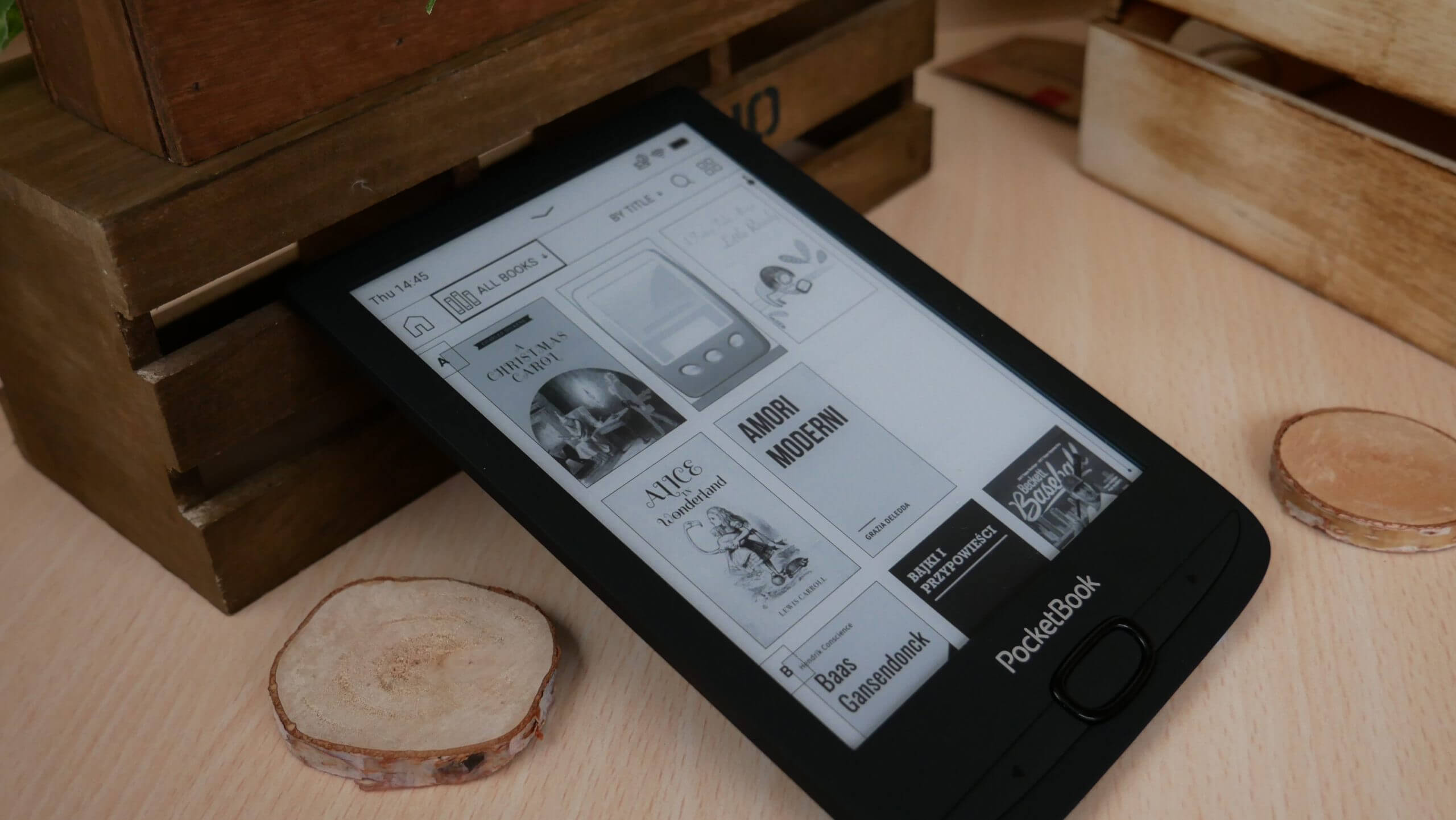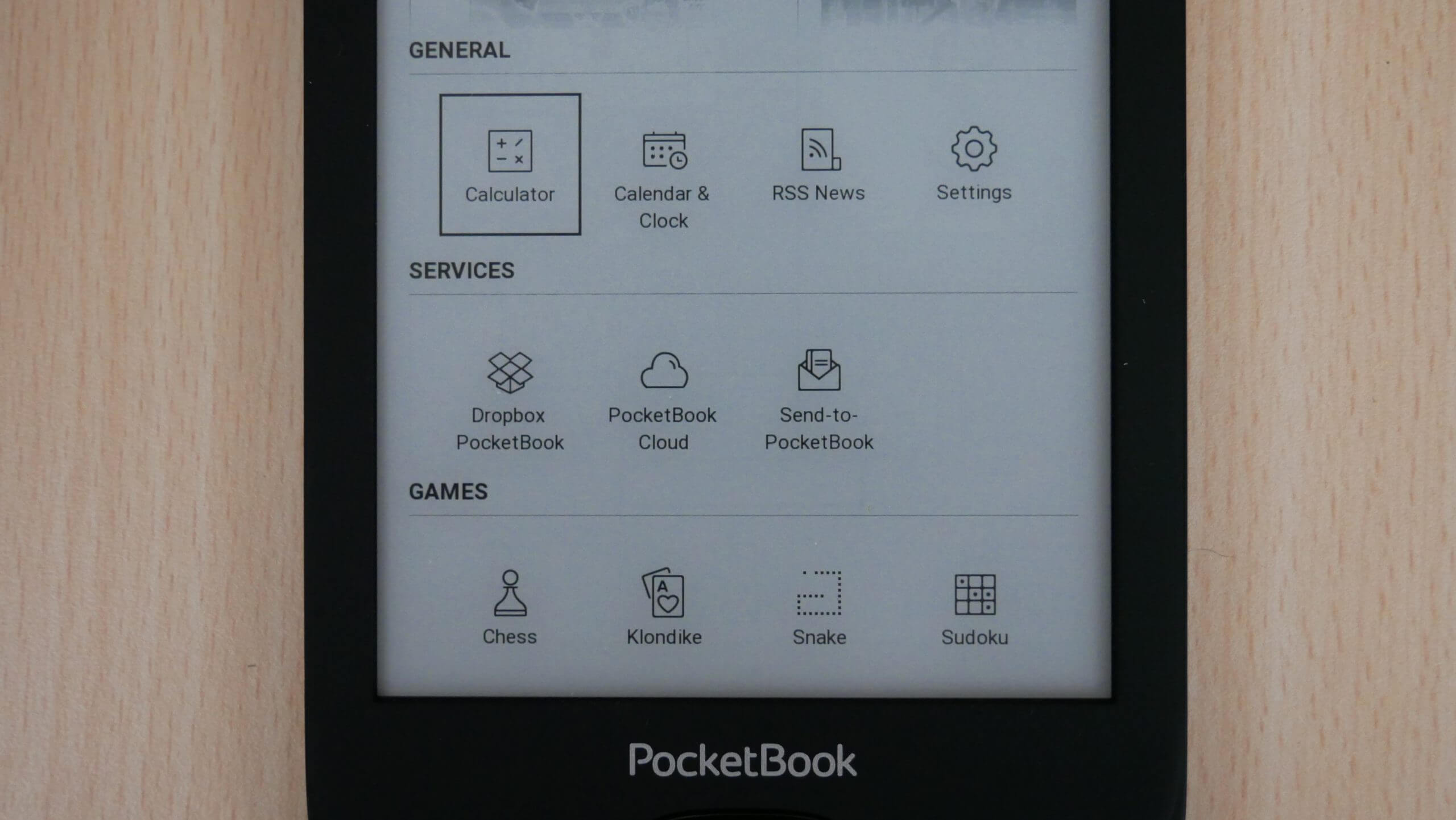The Pocketbook Basic Lux 3 e-reader is barebones. It does not have a touchscreen or note taking functionality. It has a D-Pad and manual page turn buttons to control the entire browsing and navigation experience, but it is very robust at this task. The major selling points are the $99 price tag, which makes it very affordable, it also has a dual-core processor and an SD card. Why should you buy this device? There are many people who grew up with game consoles and phones that did not have touchscreens and relied entirely on buttons. This harkens back to the days of the Game Boy or Sega Game Gear and most of the early phones from Blackberry or Nokia. They will feel right at home with the Basic Lux 3, whereas kids who grew up with tablets and fully featured smartphones, might not be the target market.
Hardware
The Pocketbook Basic Lux 3 features a 6-inch E Ink Carta screen with a resolution of 758 x 1024 pixels and 212 PPI. This reader has a sunken screen and bezel design, which means the screen is not protected by a layer of glass. This provides razer sharp text and fonts when reading books, but all of the navigation elements really pop. You can read at night or in lowlight conditions with the Smartlight system. There are a series of amber and white LED lights alongside the bezel, that project light evenly across the screen. The distribution of light is nice and even, there are no grey splotches at the corners.
Underneath the hood is a new dual-core 1 GHZ processor and 512MB of RAM. There is 8GB of internal storage, which should be enough for hundreds of books and PDF files. One of the big advantages is the inclusion of the SD card. It is capable of housing at additional 32GB of digital content. It is powered by an underwhelming 1300 mAh battery, which is the same one the Kobo Sage employs. It has an older Micro USB port, instead of USB-C, but this e-reader is cheap and cheerful. The dimensions are 161x108x8mm and weighs 166g.
One of Pocketbooks strengths is the manual page turn buttons. Most other vendors have abandoned physical buttons, and make the customers rely on the touchscreen display. Pocketbook Basic Lux 3 has the page turn buttons on the bottom of the screen, so you can easily click those to control the ebook experience. There is also a mini d-pad in the middle of the screen, with an OK button in the center. You can control the entire device with the d-pad, from accessing the lighting options to browsing around the home screen to clicking on your library and clicking on a book you want to read. There are many elements such as a file browser, internet browser, a few games such as Snake and Sudoku and a ton of different Pocketbook Services, such as cloud storage. I have found that browsing around is super responsive and robust. Navigation, opening things and even page turns in an ebook was way faster than I thought it would be. This is likely due to the software tweaks that Pocketbook had to make to this e-reader a reality. This is one of the first ones in the modern era that not included a touchscreen. Using just the buttons and d-pad takes some getting used to.
There is no USB-C, Bluetooth, audio or note taking on the Basic Lux 3, instead it is aimed at a price conscious audience. People who maybe never had an e-reader before, and only read on their smartphone, tablet or computer. Reading an on E INK screen, especially one with no glass screen, provides the best experience for your eyes. If you take it outside, there is no glare from the sun, since e-paper absorbs light, and doesn’t reflect it. This is as close as you will get to reading a real book, but digitally.
Software
Pocketbook uses Linux as their core operating system. This makes the UI and menu system the same on all of their devices. They can use virtually the same settings menu, library or file browser, alongside all of the proprietary applications they have developed. This makes it very consistent, so people who had a Pocketbook 3-4 years ago, will feel right at home on a modern device.
The big change with the experience on the Pocketbook 617, or the Basic Luc 3 is the d-pad and menu navigation buttons. Each thing that is selected, as a highlight on it. So you if you are navigating around the home screen, such as selecting the most recent book you sideloaded to the device or want to enter a WIFI network login and password at the top of the UI, everything has a black selection window, surrounding what you are selecting. This gives you visual cues on exactly where you are, so you don’t feel lost. The entire navigation experience, and opening up programs, is very fast. Normally, with touchscreen e-readers, there is a small delay, when you click on something and when the process completes. I think what Pocketbook has done with their d-pad navigation, is when you highlight something, it half-loads, so when you click OK on something, it instantly loads, almost like a pre-caching type of system.
The main UI has a series of navigation tabs, that do not have boarders around them and are spaced evenly. This includes the library, notes, dictionary, gallery and apps. The library comprises of all of the pre-loaded classic ebooks that come bundled with the Pocketbook, in a dozen different languages. Pocketbook has always embraced an international audience to drive growth for their lineup of e-readers. They support most western languages that are popular in all over Europe, North and South America. Notes, comprises of all of the highlights and notes you have made in ebooks, dictionary has a number of supported ones, and you can lookup words. Gallery is where all of your pictures are housed, it supports only a few formats, such as GIF, PNG, BMP, TIFF and JPEG. Apps is where all of the pre-loaded games are, such as Snake, Sudoku and Chess. It also comprises of all of the different Pocketbook services, such as; The PocketBook Cloud and the PocketBook Reader mobile application allow you to conveniently synchronize the library between the reader and other devices (smartphone, tablet, laptop). Also, Internet access allows you to quickly download updates and move books to the reader using the Send-to-PocketBook and Dropbox PocketBook functions.
At the very top of the UI is an arrow button. This is where you can easily establish a WIFI network, put it into airplane mode, search for firmware updates and login to various Pocketbook services. Adjusting the front-lit display and color temperature sliders are also housed here. You can enable or disable them entirely, and use the d-pad to control the brightness levels. There is an auto feature, which will automatically adjust the brightness levels based on the time of day, using the clock.
Reading Experience
The Basic Lux 3 is primary an ebook reader and it supports a wide array of formats. Since you will be sideloading in your own collection of content, since there is no bookstore on the device. It can read PDF, EPUB, TXT, FB2, RTF, HTML, CHM, DJVU, DOC, DOCX, RTF, and TCR. I wish this model supported CBZ and CBR, since many other Pocketbook models do, maybe they will introduce it in a future firmware update, like they have done with their more premium models.
There is a tactile satisfaction when reading ebooks when you have to turn the pages with buttons. It gives you a chance to turn your brain off for second and pause, before having to turn a page. This is why so people love reading paper books, because you have to physically turn a page, whereas reading books, magazines or newspapers on a tablet or smartphone, it is instant.
The page turn experience on a standard EPUB book, is lightning quick. Only the new Paperwhite 11th generation is quicker. You will not have to wait at all, of the pages to turn completely, after pressing on the button. You also have plenty of options to configure various fonts, font size, margins, line spacing, margins or just use the publisher defaults. You can sideload in your fonts by plugging the reader into your PC via the Micro USB to USB A cable. You can download your favorites such as Nickle from Kobo or Bookerly from Amazon, I love those fonts.
The Pocketbook can also read complex PDF files, and for some reason, rapidly turning the pages is so fast. This shouldn’t be possible, but it is. I have used $500 to $1200 E INK devices with large screens, 6GB of RAM, quad-core processors and Android 11, and they all struggle with turning pages of large PDF files that range from 100MB to 600MB in size. It is not like the Pocketbook is using an A2 mode, to turn a page quickly, and then the screen refreshes to show the full resolution image, every page turn has full image clarity. This includes PDF editions of magazines or manga.
Wrap up
The fact the Pocketbook Basic Lux 3 has so many things going against it, it is a miracle that it perms so well and they got the cost down to $99. This puts it in impulse buy territory. I really like how once you get into the reading experience, it is so fluid. Page turns are lightning quick, whether you are reading an EPUB or complex PDF file. Navigating around and getting setup takes some getting used to, but once you have been using it for a week, it becomes second nature. I constantly found myself trying to touch the screen and nothing happened, but muscle memory is a tricky thing to overcome, which might be the biggest hurdle facing it.
I would recommend this device for new users, who are tech savvy. They need to be able to know where they can download books for free online and how to sideload them. This process can be done via the Mac or Windows Explorer, by simply dragging and dropping files. Calibre is also a viable alternative, which will include all of the book metadata on your reader and download cover art, if your book is missing it. It will also make individual folders for each title, which helps with file management.
I would not recommend it for completely new users, whose past experience was just using the Libby or Kindle app on their phone. If you are going to buy an e-ereader, you likely want one with a full and rich ecosystem, which has millions of free and paid titles to download at a click of a button. The Pocketbook, is a bit more complex.
Michael Kozlowski is the editor-in-chief at Good e-Reader and has written about audiobooks and e-readers for the past fifteen years. Newspapers and websites such as the CBC, CNET, Engadget, Huffington Post and the New York Times have picked up his articles. He Lives in Vancouver, British Columbia, Canada.






